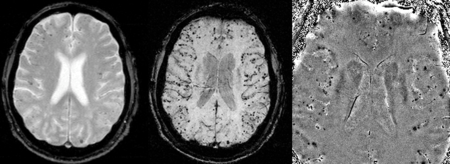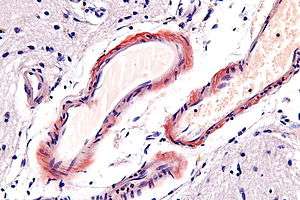Cerebral amyloid angiopathy
| Cerebral amyloid angiopathy | |
|---|---|
|
Congo red stain | |
| Classification and external resources | |
| Specialty | cardiology |
| ICD-10 | I68.0 |
| DiseasesDB | 32874 |
| MedlinePlus | 000719 |
| eMedicine | neuro/628 |
| MeSH | D016657 |
Cerebral amyloid angiopathy (CAA), also known as congophilic angiopathy,[1] is a form of angiopathy in which amyloid deposits form in the walls of the blood vessels of the central nervous system.[2] The term congophilic is used because the presence of the abnormal aggregations of amyloid can be demonstrated by microscopic examination of brain tissue after application of a special stain called Congo red. The amyloid material is only found in the brain and as such the disease is not related to other forms of amyloidosis.[3]
Signs and symptoms
Since this can be caused by the same amyloid protein that is associated with Alzheimer's dementia, brain bleeds[4] are more common in people who suffer from Alzheimer's, however they can also occur in those who have no history of dementia. The bleeding within the brain is usually confined to a particular lobe[5] and this is slightly different compared to brain bleeds which occur as a consequence of high blood pressure (hypertension) - a more common cause of a hemorrhagic stroke (or bleeding in the brain).[6]
Causes
CAA has been identified as occurring either sporadically (generally in elderly populations)[7] or in familial forms such as Flemish, Iowa, and Dutch types. In all cases, it is defined by the deposition of Aβ in the leptomeningal and cerebral vessel walls.[8] CAA occurring in the Flemish type has been observed to be linked to large dense-core plaques observed in this pedigree.[9]
The reason for increased deposition of Aβ in sporadic CAA is still unclear with both increased production of the peptide and abnormal clearance having been proposed as potential causes.[10] Under normal physiology Aβ is cleared from the brain by four pathways: (1) endocytosis by astrocytes and microglial cells, (2) enzymatic degradation by neprilysin or insulysin(3) cleared by way of the blood brain barrier or (4) drained along periarterial spaces. Abnormalities in each of these identified clearance pathways have been linked to CAA.[11][12]
In familial forms of CAA, the cause of Aβ build up is likely due to increased production rather than poor clearance.[13] Mutations in the amyloid precursor protein (APP), Presenilin (PS) 1 and PS2 genes can result in increased rates of cleavage of the APP into Aβ. An immune mechanism has also been proposed.[14][15]
Diagnosis

Susceptibility weighted imaging has been proposed as a tool for identifying CAA-related microhemorrhages.[17] Biopsies also play a role in diagnosing the condition.[18]
Types
It is usually associated with amyloid beta.[19]
However, there are other types:
- the "Icelandic type" is associated with Cystatin C[20]
- the "British type" is associated with ITM2B[21]
Research is currently being conducted to determine if there is a link between cerebral amyloid angiopathy and ingestion of excessive quantities of aluminum.[22]
Management
The aim in cerebral amyloid angiopathy is to treat the symptoms, as there is no current cure. Physical and/or speech therapist may be helpful in the management process of this condition.[2]
References
- ↑ Exley C, Esiri MM (July 2006). "Severe cerebral congophilic angiopathy coincident with increased brain aluminium in a resident of Camelford, Cornwall, UK". J. Neurol. Neurosurg. Psychiatr. 77 (7): 877–9. doi:10.1136/jnnp.2005.086553. PMC 2117501
 . PMID 16627535.
. PMID 16627535. - 1 2 "Cerebral amyloid angiopathy: MedlinePlus Medical Encyclopedia". www.nlm.nih.gov. Retrieved 2015-05-27.
- ↑ Newfoundland, FRCP William Pryse-Phillips MD, FRCP(C) Faculty of Medicine Health Sciences Centre Memorial University of Newfoundland St John's (2009-05-06). Companion to Clinical Neurology. Oxford University Press, USA. ISBN 9780199710041.
- ↑ Godefroy, Olivier (2013-02-28). The Behavioral and Cognitive Neurology of Stroke. Cambridge University Press. ISBN 9781107310896.
- ↑ Coleman, William B.; Tsongalis, Gregory J. (2010-02-16). Essential Concepts in Molecular Pathology. Academic Press. ISBN 9780080922188.
- ↑ "Brain Basics: Preventing Stroke: National Institute of Neurological Disorders and Stroke (NINDS)". www.ninds.nih.gov. Retrieved 2015-05-27.
- ↑ Sirven, Joseph I.; Malamut, Barbara L. (2008). Clinical Neurology of the Older Adult. Lippincott Williams & Wilkins. ISBN 9780781769471.
- ↑ Ettinger, Alan B.; Weisbrot, Deborah M. (2014-04-17). Neurologic Differential Diagnosis: A Case-Based Approach. Cambridge University Press. ISBN 9781107014558.
- ↑ Kumar-Singh, S.; Cras, P.; et al. (2002). "Dense-core senile plaques in the Flemish variant of Alzheimer's disease are vasocentric". American Journal of Pathology. 161: 507–20. doi:10.1016/S0002-9440(10)64207-1. PMID 12163376.
- ↑ Tolnay, Markus; Probst, Alphonse (2012-12-06). Neuropathology and Genetics of Dementia. Springer Science & Business Media. ISBN 9781461512493.
- ↑ Subramaniam, Rathan; Barrio, Jorge (2013-10-15). Novel Imaging Techniques in Neurodegenerative and Movement Disorders, an Issue of Pet Clinics. Elsevier Health Sciences. ISBN 9780323227353.
- ↑ Brain Extracellular Matrix in Health and Disease. Elsevier. 2014-10-30. ISBN 9780444634948.
- ↑ Hall, Tim (2013-09-17). PACES for the MRCP: with 250 Clinical Cases. Elsevier Health Sciences. ISBN 0702054666.
- ↑ Mental Disorders: New Insights for the Healthcare Professional: 2011 Edition. ScholarlyEditions. 2012-01-09. ISBN 9781464900853.
- ↑ Advances in Dementia Research and Treatment: 2012 Edition. ScholarlyEditions. 2012-12-26. ISBN 9781464991721.
- ↑ Mittal, S.; Wu, Z.; Neelavalli, J.; Haacke, E. M. (2009). "Susceptibility-Weighted Imaging: Technical Aspects and Clinical Applications, Part 2". American Journal of Neuroradiology. 30 (2): 232–252. doi:10.3174/ajnr.A1461. ISSN 0195-6108. PMID 19131406.
- ↑ Ellenbogen, Richard G.; Abdulrauf, Saleem I.; Sekhar, Laligam N. (2012). Principles of Neurological Surgery. Elsevier Health Sciences. ISBN 1437707017.
- ↑ Verbeek, M. M.; Waal, R. M. de; Vinters, Harry V. (2013-06-29). Cerebral Amyloid Angiopathy in Alzheimer’s Disease and Related Disorders. Springer Science & Business Media. ISBN 9789401710077.
- ↑ Dickson, Dennis; Weller, Roy O. (2011-09-09). Neurodegeneration: The Molecular Pathology of Dementia and Movement Disorders. John Wiley & Sons. ISBN 9781444341232.
- ↑ Larner, A. J. (2008-04-24). Neuropsychological Neurology: The Neurocognitive Impairments of Neurological Disorders. Cambridge University Press. ISBN 9780521717922.
- ↑ Dening, Tom; Thomas, Alan (2013-09-26). Oxford Textbook of Old Age Psychiatry. OUP Oxford. ISBN 9780199644957.
- ↑ Kawahara, Masahiro; Kato-Negishi, Midori (2011). "Link between Aluminum and the Pathogenesis of Alzheimer's Disease: The Integration of the Aluminum and Amyloid Cascade Hypotheses". International Journal of Alzheimer's Disease. 2011: 1–17. doi:10.4061/2011/276393. ISSN 2090-0252. PMC 3056430
 . PMID 21423554.
. PMID 21423554.
External links
- Chao, Christine P.; Kotsenas, Amy L.; Broderick, Daniel F. (September 1, 2006). "Cerebral Amyloid Angiopathy: CT and MR Imaging Findings". RadioGraphics. 26 (5): 1517–1531. doi:10.1148/rg.265055090. ISSN 0271-5333. PMID 16973779.
